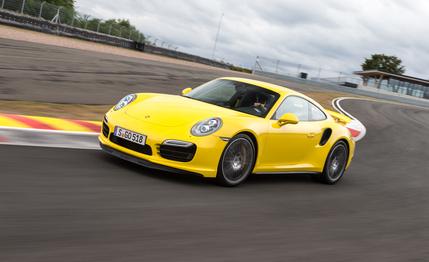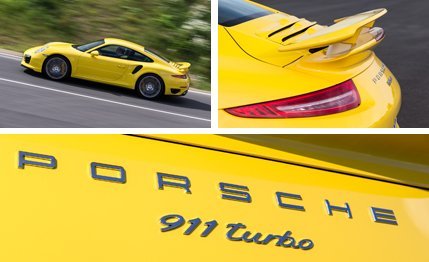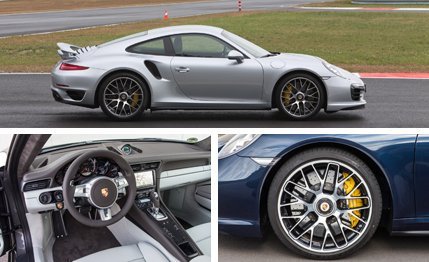 First Drive Review
First Drive Review
The Bilster Berg Drive Resort is a private club track in central Germany that squiggles over hill and dale at the top of a small mountain where there once was a British Army ammo dump. It’s not a track-map sticker you really want for your car, as the circuit is shaped almost exactly like the large intestine. And people in our group kept calling it “Blister Berg,” the mountain of blisters. The Germans just stared as they ladled out the lunch of roasted pig knuckles.
The famous Porsche wheelman Walter Röhrl consulted on the design, which is a tossed salad of hidden apexes just past blind crests leading to off-camber death-drops. It’s a great, if scary, place to drive the new Porsche 911 Turbo because it proves how shockingly well this 3550-pound touring coupe can do something it is not expected to do much of: track work.

Porsche’s intention is to give you it all. Blistering speed, of course, but, just as important, daily usability, the comfort of a sheik’s casbah, and the best fuel efficiency possible in a 911 offering up to 560 horsepower. In cracking its lid and packing in even more horses, the car’s keister swells by yet another 1.1 inches from its predecessor. The 911 Turbo has always had hips you want to grab with both hands and squeeze, but now, from the back, the new Turbo looks like a Peter Paul Rubens scene in CinemaScope.
Porsche is compelled to turn up the wick to fend off interlopers in the $150,000-to-$200,000 sandbox where the Turbo now plays. There are AMGs, Aston Martins, and Audi R8s rattling around in this space, plus the forthcoming McLaren P13. Hence, both the base Turbo and the Turbo S are for the first time being launched simultaneously, for $149,250 and $182,050, respectively. The price difference basically pays for all the Turbo’s performance options including carbon-ceramic brakes, plus 40 horsepower, center-lock forged wheels, slightly different air intakes up front, and the all-important “S” badge.

Strapped with twin BorgWarner compressors using variable-vane geometry, originally a technology for spinning up turbos faster in diesels, the 3.8-liter flat-six encases new shorter-skirt pistons and forged connecting rods among the modifications needed to handle both 14.5 psi of whistling boost and a 9.8:1 compression ratio. If 520 horsepower isn’t enough, the Turbo S makes 560 on 17.4 psi, with a torque peak of 516 pound-feet arriving at just 2100 rpm. Both cars can squirt another 2.2 psi into their pots on temporary overboost.
With the one transmission available in all Turbos—the seven-speed dual-clutch PDK—locked into its optional launch control, the ETA for 60 mph should be 2.7 seconds in the S. Porsche encouraged us to launch the car as many times as we liked, and the perfectly repeatable violence of it is terrifying. If you don’t have your head against the backrest before detonation, you’ll feel it in the morning. More technology: A revised four-wheel-drive system switches from the base Carrera 4’s ball-ramp-activated front-axle coupling to a new liquid-cooled Haldex hydraulic device (both are electronically controlled). Engineers say the extra precision offered by hydraulic control allows for better tuning of the torque-vectoring feature. An electronically controlled limited-slip rear differential combined with single-rear-wheel brake applications helps steer the car into corners. Rear-wheel steering, as in the new GT3, also sharpens the car’s reflexes, while its aerodynamic downforce automatically elevates at speed via a height- and angle-adjustable rear wing and a flexible three-section chin spoiler that drops down in two phases via air bladders. At low speed, the black lip stays retracted out of the scrape zone.
And Then ... 2001 911 Turbo (996) On top of a water-cooled engine, Porsche adds to the Turbo its VarioCam Plus system, which is variable intake valve timing, lift, and duration. A five-speed Tiptronic is the Turbo's first automatic, and the Turbo Cabriolet becomes a full-fledged model. (Previous droptops came out of Porsche Exclusive.) Whether two or three pedals, fixed or folding roof, the Turbo has lost some soul. We call it "an appliance for speed." Porsche makes the naturally aspirated GT3 its racing focus, and the 456-hp GT2 adopts a fully carpeted interior. Price: $116,818 Horsepower: 415

Porsche shakes up this bag of tricks and dumps out not a hyper sports car or a homologated Le Mans entry, as the Turbo once was, but a cucumber-cool super GT for racing Gulfstream jets across continents. It has the requisite tools for managing all that horsepower on track or autobahn in a way that is safe and highly approachable, yet at the cost of becoming slightly anodyne and filtered, from the target-seeking steering that also swallows up bumps to the muted engine song to the brakes. While capable of oblonging your eyeballs, the brakes sometimes exhibited computer tampering in the form of strangely variable pedal resistance.
Still, if our soft hands weren’t exactly blistered, they were definitely shaking after five laps. Such is the new Turbo’s fearsome acceleration and lateral grip that even our group of jaded media veterans had to shake their heads at the marvel that modern technology has wrought.